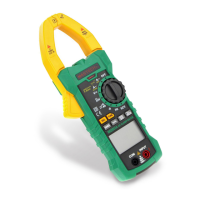25 26
(1) Insert black probe to COM jack, insert red probe to
NPUT ack.
(2) Transfer switch is placed to position HZ.
(3) Connect the probe with sinal or both ends of load in
parallel for measurement.
(4) Read on the LCD.
(5) Pressing “Hz/%” again can enter duty ratio measuring
state.
Frequency measurement range is 10Hz~1kHz When the
frequency to be tested is more than 10Hz,the CD will show
0.0measuring frequency higher than 10 kHz is possible,
but accuracy is not guarantee
Note:
4.13 Resistance Test
Electric shock hazard.
When measuring circuit impedance,
determine that the power supply is
disconnected and the capacitor in the circuit
is completely discharged.
Warning
1) Insert black probe to COM jack, insert red probe to
INPUT jack.
2) Place measuring range switch to position. At this
time, the meter is in the measurement state.
3) Connect the probe to the both ends of resistor or circuit
to be tested for measurement.
4) LCD will show readings.
Note:
1) When the input end is open, LCD shows “0L” outrange
state.
2) When the resistance to be tested>1M, the meter reading
will stablilizee after a few seconds, which is normal for
high resistance readings.
4.14 Diode Test
1) Insert black probe to COM jack, insert red probe to
INPUT jack.
2) Measuring switch is placed to position
3) Press “FUNC” key to switch to measuring state.
4) Connect the red probe to diode anode and connect the
black probe to diode cathode to make test.
5) Read on the LCD.
1) What the meter shows is approximation of diode
forward voltage drop.
2) If the probe has reverse connection or the probe is
open, the LCD will show “0L”.
Note:
4.15 Circuit Continuity Test
Electric shock hazard.
When measuring circuit continuity, determine
that the power supply is disconnected and the
capacitor in the circuit is completely discharged.
Warning
1) Insert black probe to COM jack, insert red probe to
INPUT jack.
2) Measuring switch is placed to position
Ω
Ω
Ω

